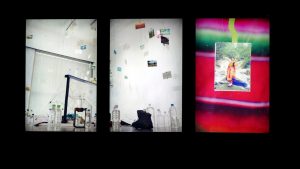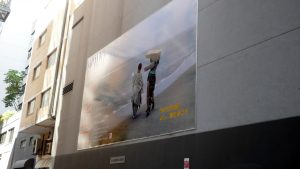Drawing Water: a cross-cultural, cross-institutional collaborative art project
An excerpt … “Circulation”
written by Prof. Hirotoshi Sakaguchi (Translation: Sachiko Suzuki)
 As the Tokyo workshop phase of the Drawing Water project drew closer, three typhoons struck Japan. This was an unusual weather pattern. Due to the earth’s rotation, typhoons rotate clockwise in the southern hemisphere, and counterclockwise in the northern hemisphere. Typhoons circulate water and stir up air and water temperatures. These factors are not only important for Japan, they are also vital to the planet; the circulation of water plays a big function in the circulation of solar heat.
As the Tokyo workshop phase of the Drawing Water project drew closer, three typhoons struck Japan. This was an unusual weather pattern. Due to the earth’s rotation, typhoons rotate clockwise in the southern hemisphere, and counterclockwise in the northern hemisphere. Typhoons circulate water and stir up air and water temperatures. These factors are not only important for Japan, they are also vital to the planet; the circulation of water plays a big function in the circulation of solar heat.
1. The history of Tokyo’s water
The contemporary city of Tokyo is built on the historical city of Edo. Between 1603 and 1868, during what is known as the Edo period, the city held 2,600,000 residents. It was unique in the world as the first metropolis to use urban sanitation before the Industrial Revolution. In order to achieve this, city planners had changed the flow  of the river and transformed Edo in the process. The river had an abundance of clean water, and huge construction programs were used to build waterways such as Tamagawa-Josui that could draw the drinking water to the center of the city. Canals such as this became pathways for water transportation. The reconstructions of the river also changed the flow of the river. The area around Edo castle, was divided into land for the fortifications and a residential area that were separated by the diverted pathways of the river. In this way the ‘lungs’ of the city were recirculated and a new relationship between land and water was restored.
of the river and transformed Edo in the process. The river had an abundance of clean water, and huge construction programs were used to build waterways such as Tamagawa-Josui that could draw the drinking water to the center of the city. Canals such as this became pathways for water transportation. The reconstructions of the river also changed the flow of the river. The area around Edo castle, was divided into land for the fortifications and a residential area that were separated by the diverted pathways of the river. In this way the ‘lungs’ of the city were recirculated and a new relationship between land and water was restored.
2. The problems about water in the future
However, history warns us that man-made attempts to redirect or harvest water-flow come at a price. In 1971, when the Aswan High Dam was completed in the Nile, in Egypt, water resources in Egypt were more able to be reserved and controlled, especially for the thirsty urban metropolises. However, the supply of nutrition rich water became inadequate for other assets and fishery resources suffered as a result. Similar problems arise for agriculture when drawing the groundwater is used for controlled mono-cultural plantations. Outcomes such as these make it clear how vital it is that we pay careful heed to caring for the health of this watery planet, Earth, through scientific approaches informed by macroscopic perspectives…
 The above excerpt is one of a number of stories contained within the online publication that forms part of a collaborative project – Drawing Water. This project involves students from three institutions: Queensland College of Art, Griffith University, Geidai (Tokyo University of the Arts) and Joshibi University of Art and Design in Tokyo and is initiated and lead by co-curators Pat Hoffie and Linda Dennis (Joshibi). The Drawing Water initiative incorporates a series of public exhibitions, videos, online works and a major online publication which includes contributions from leading scholars.
The above excerpt is one of a number of stories contained within the online publication that forms part of a collaborative project – Drawing Water. This project involves students from three institutions: Queensland College of Art, Griffith University, Geidai (Tokyo University of the Arts) and Joshibi University of Art and Design in Tokyo and is initiated and lead by co-curators Pat Hoffie and Linda Dennis (Joshibi). The Drawing Water initiative incorporates a series of public exhibitions, videos, online works and a major online publication which includes contributions from leading scholars.
We are delighted to share that two of the essay contributions for the online publication are written by members of Water Future, namely Essay 11 – ‘Drawn To Water’ by Liz O’Brien and Essay 12 – ‘Water: Connecting People and Country’ by Sue Jackson. Liz O’Brien is a valuable member of the International Secretariat, whilst Sue Jackson is a Member of the  Environmental Flows Working Group and also a Member of the Water Ethics Working Group.
Environmental Flows Working Group and also a Member of the Water Ethics Working Group.
We encourage you to follow the links below to discover more about the project and enjoy the stories from our members, and others.
Further Information:
- Drawing Water: DIG Tokyo 2016
- Drawing Water: a cross-cultural, cross-institutional collaborative project
- Drawing Water: online publication
Acknowledgement
Special thanks go to Pat Hoffie, Queensland College of Art, Griffith University for permission to post this article.
Photos courtesy of: Bill Platz